Even the tiniest component can have a massive role in machining. Washers are typically disc-shaped pieces that play essential roles in distributing load, preventing leakages, or even locking parts in place.
But not all washers are created equal. They vary greatly based on their design, application, and the specific problem they aim to address. Manufacturing these components must therefore take into account the different designs and categories of washers. ProleanTech, with extensive and diverse manufacturing experience, provides custom washer manufacturing services for any industry.
Let’s take a deep look at the diverse types of washers and their applications.
What Are the Washers?
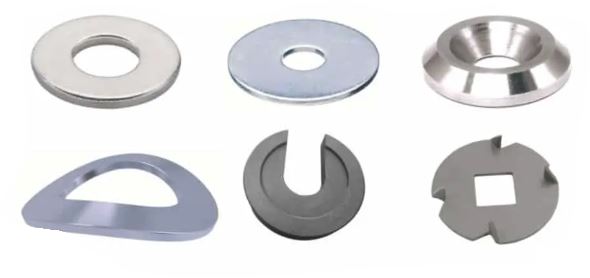
Mechanical washer examples
A washer is a thin plate, typically disk-shaped with a hole in the middle. Made from a variety of materials like steel, brass, rubber, or plastic, washers are often found nestled between a bolt and the surface it’s affixed to. While their appearance is simple, their functions can range from distributing load to minimizing vibrations.
The first recorded use of “washer” was in 1346, with another source in 1611 using the word and describing its use: to reduce wear on axle hubs in artillery applications. The washer’s current use is a clue to its invention. The main purpose was probably to prevent loosening of bolts (which in the days of animal-drawn wagons was a surefire way to cause serious wheel problems) and to reduce wear. Other modern uses include distributing loads over a larger area, acting as a spacer or locking device, reducing vibration, and preventing the ingress of liquids.Read more
In essence, washers serve as a bridge, often mediating between two surfaces, ensuring that the forces involved are evenly distributed. Without them, irregularities in the surfaces can lead to wear and tear or even structural failure.
Why Use Washers?
In any assembly, washers are far from just an afterthought. Their importance is underscored by the multiple roles they play based on the types of washers. The main applications of washers are load distribution, leakage prevention, enhancing grip, and others.
Here is a brief overview of these applications:
- Load DistributionBy spreading the load of a threaded fastener, washers ensure that there isn’t excessive pressure on one specific point. This function is particularly beneficial when the bolt or screw is fastened to a soft material. Distributing the load prevents the fastener from sinking into the material or causing potential damage.
- Prevention of LeakagesIn plumbing and hydraulic systems, washers, especially those made from rubber or other flexible materials, act as seals. They prevent fluids from escaping, ensuring the system’s efficiency and safety. Even the tiniest leak can escalate to a significant issue, leading to wasted resources and potential hazards.
- Protection and InsulationWashers can also act as insulators, especially when they’re crafted from non-conductive materials. In electrical applications, this insulation prevents unintended circuits or potential shorting. Besides, they also protect surfaces from being scratched or marred by the turning action of nuts and bolts.
- Enhancing Grip and Reducing VibrationSome washers, especially those designed with serrations or a spring-like structure, grip onto surfaces. This grip reduces the likelihood of the fastener loosening due to vibrations. Such a feature is invaluable in machinery or applications where constant motion is the norm.
- Compensation for Oversized or Misaligned HolesOccasionally, holes drilled for fasteners might not align perfectly or might be larger than necessary. Washers, in these instances, can compensate for such discrepancies, ensuring that the fastener sits snugly and functions optimally.
- Compensation for Oversized or Misaligned Holes Occasionally, holes drilled for fasteners might not align perfectly or might be larger than necessary. Washers, in these instances, can compensate for such discrepancies, ensuring that the fastener sits snugly and functions optimally.
Types of Washers for Bolts and Their Uses: Three Main Types
Bolts, a fundamental element in countless assemblies, often require specific types of washers to function optimally. The right washer type can make the difference between a secure, lasting connection and a weak point prone to failure.
Here, we’ll delve into the three primary types of washers used with bolts namely plain, spring, and locking washers, shedding light on their unique designs and applications.
1. Plain Washers
Also known as flat washers, these are perhaps the most commonly recognized. With a simple, flat design and a central hole, their primary role is to distribute the load of a bolt or screw evenly across the surface. This distribution is critical, especially when working with soft materials that might otherwise get damaged under the pressure of a tightened bolt.
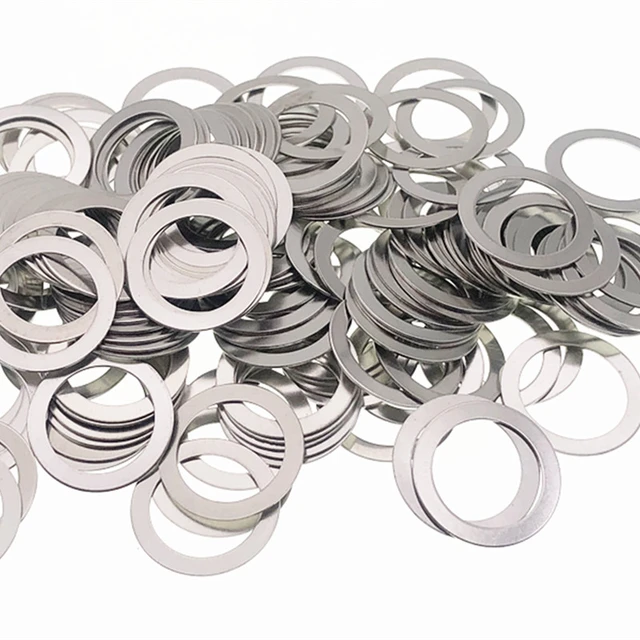
Plain washers
Uses:Distributing loads to prevent surface distortion, compensating for oversized holes, and providing a smooth-even surface for the bolt’s head or nut to press against.
2. Spring Washers
Characterized by their axial flexibility, spring washers look different from the typical flat washer. Their design often includes a split or a wave, enabling them to exert a spring force between the fastener’s head and the substrate. This unique feature makes them invaluable in applications prone to vibrations.
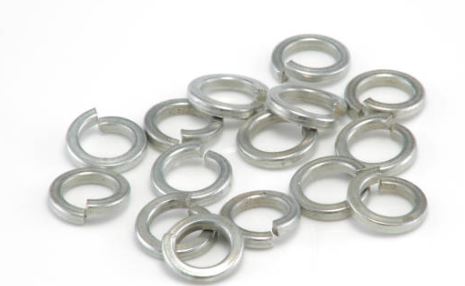
Spring washer
Uses:
- Counteracting the effects of vibration and preventing bolted joints from loosening.
- Maintaining tension in bolted joints, especially in scenarios where thermal expansion and contraction are frequent.
- Acting as shock absorbers in certain assemblies.
3. Locking Washers
Locking washers, as their name suggests, are all about ensuring that the bolt stays in place. Their design typically includes teeth or prongs which grip the surfaces, preventing any movement or loosening of the bolt. They’re especially valuable in applications where safety is paramount or where regular checks and maintenance might be challenging.

Steel split washer lying on gray background, close-up
Locking washer
Uses:
- Providing added security to bolted connections, ensuring they remain tight.
- Creating friction between the bolt head or nut and the installation surface, further reducing the chances of loosening.
- Offering resistance against both rotation (due to external forces) and vibrations.
Breaking Down the Plain Washers
Plain washers, often regarded as the unsung heroes of the fastening world, hold a more significant place in engineering and construction than most realize. These small, usually flat components are vital for ensuring that the force applied by a nut or bolt is distributed evenly. However, it’s essential to note that even within this category, there are various types, each catering to a specific need.
1. Flat Washers
Perhaps the most basic and common type, flat washers are simple, flat discs with a hole in the center. They come in various sizes, matching a range of bolt sizes. These are typically made from metals like steel, stainless steel, copper, or brass. They offer a smooth, even surface for the bolt’s head or nut to press against and help in distributing loads to prevent surface distortion, especially in softer materials.
Applications: Flat washers are universal and can be found in various industries, including construction, automotive, electronics, and furniture manufacturing.
2. Fender Washers
Larger in diameter but thinner than the standard flat washer, fender washers offer an extended bearing surface. They derive their name from their use in auto body repair, particularly in fender applications.
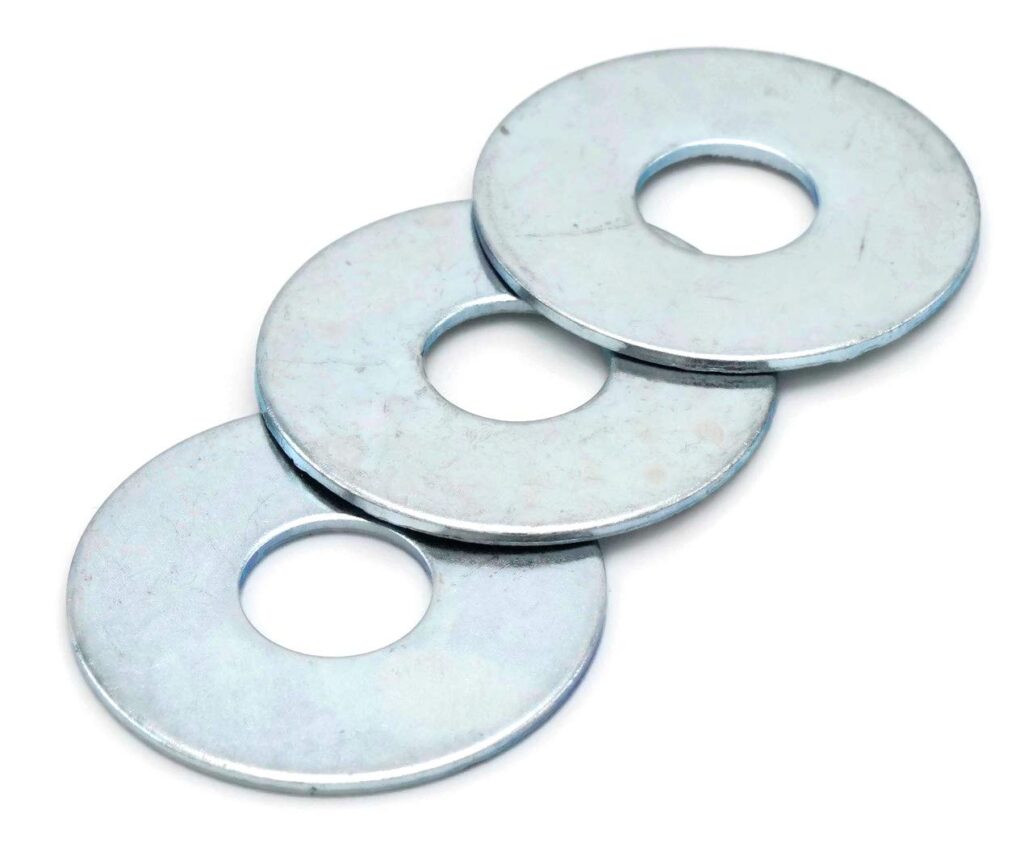
Features: Large outer diameter, primarily used to distribute load over a vast area, especially for oversized holes.
Applications: While they started in the automotive industry, fender washers are now widespread in plumbing, electrical installations, and many DIY projects where an extended distribution area is beneficial.
3. Shim Washers
These are ultra-thin washers utilized to adjust the space between two joining parts. Shim washers are exceptionally thin, offering minute adjustments and can be stacked to achieve the desired thickness.
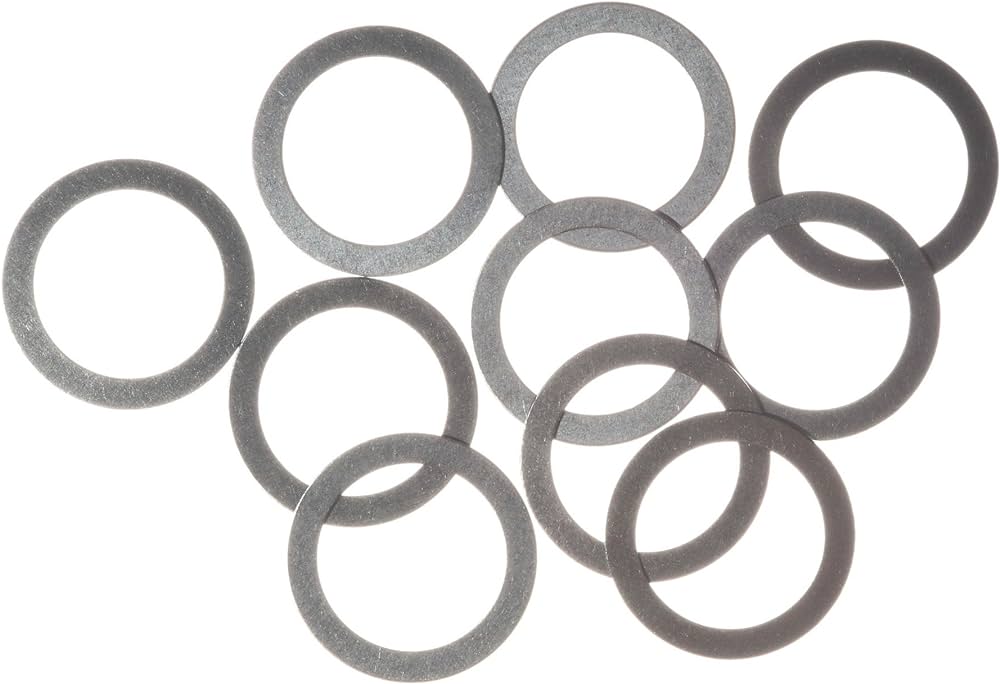
Steel shim washers
Applications: Shim washers are essential in machinery alignments, gear setups, and applications where precision spacing is critical.
4. Countersunk Washers
Specifically designed with a conical shape, countersunk washers are used with countersunk screws to ensure the screw sits flush with or below the level of the surface. The Features are conical bearing surface and typically used with flat or oval head screws.

Countersunk washers
Applications: Commonly found in applications where a smooth surface with no protruding components is necessary, like aircraft manufacturing, woodworking, and metalwork.
5. Shoulder Washers
Shoulder washers have an additional cylindrical section, apart from the flat washer part. This cylindrical section is called the ‘shoulder’ and is useful in specific applications. They provides both axial and radial spacing and ensures that the screw remains isolated from the assembly material.
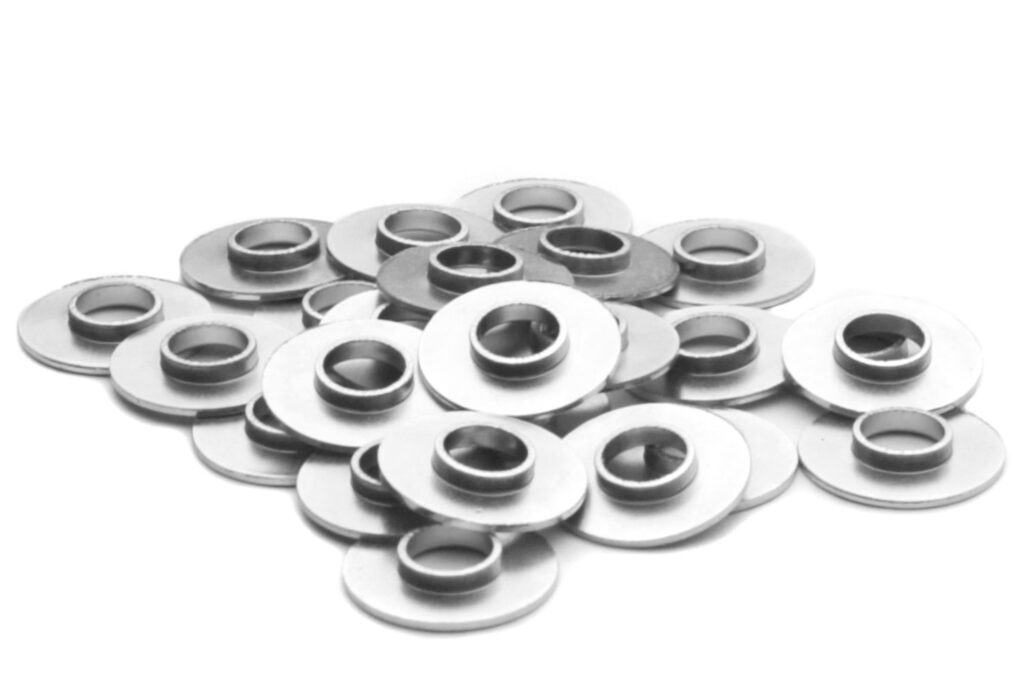
Shoulder washers
Applications: Particularly beneficial in electronic applications, where insulation between a screw and the conducting surface is essential.
6. C-Washers
Resembling the letter ‘C’ in profile, these washers are slotted or split ring-shaped, enabling them to be applied or removed without having to remove the fastening bolt or screw. C-washers can be adjusted to meet the desired spacing requirements and enables to be inserted post-assembly.
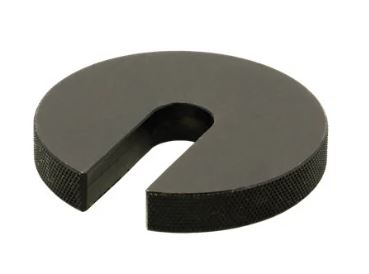
C-washer
Applications: C-washers are particularly useful in machinery where regular maintenance is required, as they allow adjustments without complete disassembly.
7. Tab Washers
These washers come with a tab that can be bent over into one of the slots, providing a locking action. They ensure the bolt remains in place, even under heavy vibration, and offer an additional layer of security in bolted connections.

Tab washer
Applications: Given their locking nature, tab washers are popular in heavy machinery and automotive applications where bolt loosening due to vibration could have serious consequences.
Breaking Down the Spring Washers
Spring washers are often termed as ‘lock washers,’ stand out for their unique design and distinct functionality. Unlike their flat counterparts, spring washers possess a certain elasticity which provides a locking action, resisting the rotation of the screw or bolt to which it’s attached. Their design aims to add a spring force to the bolted joint, compensating for any settling or thermal expansion. Delving deeper, we uncover various sub-types within this category, each with its nuanced function.
1. Split or Helical Spring Washers
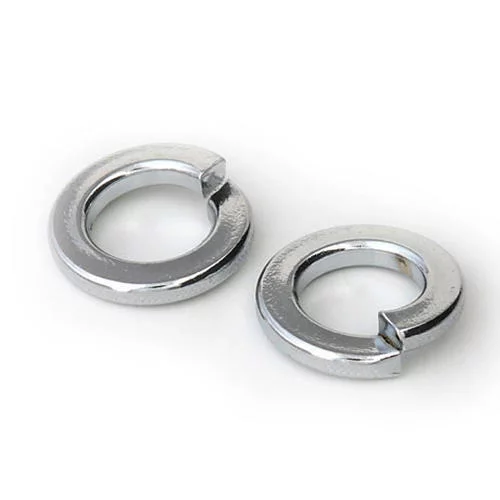
Arguably the most recognized among spring washers, split or helical washers come in a coiled shape, appearing like a section of a ring cut at an angle. They provides axial flexibility and offer a counter-force when compressed.
Applications: The angular cut ensures that the washer exerts a spring force against the nut or bolt head. This proves valuable in applications prone to vibration or dynamic loads, preventing unintentional loosening.
2. Single Coil Square Section
These washers have a more pronounced square cross-sectional area, leading to an enhanced locking force upon compression. The features includes robust locking mechanism due to the square selection and uniform spring rate over a wider deflection range.
Applications: Given their stronger grip and more consistent spring rate, these washers are suitable for demanding applications such as automotive brakes and clutch assemblies.
3. Double Coil
As the name suggests, double-coil spring washers contain two intertwined coils, usually in opposite directions. The Features include enhanced surface area, leading to better friction and locking, and dual coils counteract each other’s forces.
Applications: They find their niche in heavy machinery, where more substantial bolts require a greater locking force, especially in environments susceptible to intense vibrations.
4. Wave Washers
Wave washers, rather than relying on a coiled structure, utilize a wave-like design across their circumferential area They provide a somewhat lighter force than coil designs and offers multiple-point contact.
Applications: Wave washers are typically employed in applications necessitating a light thrust load with a limited range of motion, like electrical connectors or fastening ball bearings.
5. Belleville Washers
Shaped like a truncated cone, Belleville washers can be stacked in various combinations, enabling varying spring rates. They can be used in series or parallel stacks, and offers a high load capacity in a compact design.
Applications: Due to their stacking flexibility and high load-bearing, Belleville washers are often found in high-load, limited-space applications such as ball bearing assemblies or as a spring in clutches.
6. Crescent Washers
Designed with a crescent-like shape, these washers offer minimal deflection with relatively high forces. Crescent washers contains a a curvilinear shape that yields higher forces at minimal deflections.
Applications: Their peculiar design makes them apt for applications like semiconductor manufacturing or precision instruments where space constraints demand efficient solutions.
Breaking Down the Locking Washers
Locking washers, as their name suggests, are specialized washers designed to prevent nuts and bolts from getting loose. With numerous applications spanning industries, their role is pivotal in ensuring the stability and integrity of an assembly.
These washers often come with unique patterns or designs that increase friction and resistance to rotation. Diving into the world of locking washers, one would encounter several types, each crafted for specific needs and applications.
1. External Tooth Lock Washers
These washers sport an outer ring of teeth, adding an extra layer of locking action by biting into the bearing surface. They are effective resistance to rotational movement because the teeth provide additional grip.
Applications: Often paired with screws and nuts that have small heads, these washers are especially useful in applications where preventing rotation is of utmost importance, such as in electric motor or automotive assemblies.
2. Internal Tooth Lock Washers
Featuring teeth on the inner circumference, these are ideal for applications with larger nut or screw heads. The features of internal tooth lock washers includes inner teeth for an enhanced grip and suitable for applications with larger fastener heads.
Applications: These washers are found in areas where the external aesthetics of an assembly matter, as the internal teeth keep the external surface smooth, like in household appliances or electronics.
3. Wedge Lock Washers
These washers come in pairs, featuring ridges that interlock. As the bolt is tightened, the ridges grip and bind against each other for a secure lock They includes interlocking ridges for superior grip snd can withstand severe vibration and dynamic loads.
Applications: Given their unparalleled grip, wedge lock washers are apt for construction machinery, railways, or any environment where intense vibration is a concern.
4. Star Washers
Resembling a star with their outwardly extending tabs, these washers bite into the surface, offering a firm grip. Star-like design for maximized grip and suitable for wood or softer materials.
Applications: Their design makes them particularly useful in woodworking or for materials that are softer, where the tabs can easily grip onto the surface.
5. Nord-Lock Washers
Nord-Lock washers come with a unique design that involves a pair of washers with wedging properties, ensuring the bolt doesn’t loosen under vibration. They feature a wedge-locking design and they can withstand significant dynamic stress.
Applications: Given their resilience against dynamic stress and vibrations, they are often used in railways, bridges, and even space crafts.
Washer Manufacturing and Its Intricacies
Manufacturing washers, seemingly simple components, is quite intricate. Factors such as material choice, production method, and quality control play pivotal roles in creating efficient washers.
Delving deeper, one would realize the complexities and nuances involved in their production. ProleanTech considers several things including materials and the washer manufacturing technologies to use.
Here’s more about these critical considerations:
What Are the Common Materials for Washers?
Choosing the right material is paramount, as it dictates the washer’s durability, resistance, and functionality in various environments.
- Steel and Stainless Steel: Often chosen for its robustness and longevity. Stainless steel offers added corrosion resistance, making it apt for environments prone to moisture or chemical exposure.
- Brass: Noted for its aesthetic appeal and resistance to corrosion. Ideal for applications where appearance matters, such as in decorative fixtures.
- Copper: Favored for its excellent thermal and electrical conductivity. Widely used in electronic assemblies and plumbing.
- Rubber and Plastic: Provide a flexible option for sealing purposes or in applications where metal might be reactive.
- Aluminum: Lightweight and resistant to rust, aluminum finds its utility in aerospace and automotive industries.
While the above materials are commonly used, manufacturers must ensure that they source high-quality raw materials. This not only ensures product longevity but also satisfies industry standards.
Washers Manufacturing Methods
Given the variety in washer applications, it’s no surprise that multiple manufacturing techniques have evolved over time. These methods are tailored to produce washers that meet precise specifications, ensuring optimal performance.
Table: Various methods for washer manufacturing
| Methods | Description | Key Features/Uses |
|---|---|---|
| Punch and Die Method | The most conventional method. | A die with a washer shape punches out washer shapes from a metal strip in a punch press. |
| Laser Cutting | Suitable for intricate designs and specialty washers. | Uses a high-power laser to cut material ensuring accuracy. |
| Water Jet Cutting | Uses an abrasive water jet. | Cuts the washer without generating heat, ideal for temperature-sensitive materials. |
| Wire EDM (Electrical Discharge Machining) | Uses an electrified wire. | Cuts washers from metal sheets, ideal for intricate designs and tight tolerances. |
| Machining | Method used for specialty washers. |
To ensure efficiency in manufacturing, continuous quality checks are imperative. Employing techniques such as TQM (Total Quality Management) can assist manufacturers in maintaining quality standards. Quality checks often involve inspecting the washer’s size, shape, and any potential material defects.
Summing Up
Washers, though often overlooked, are integral components in a myriad of applications. Recognizing the right type of washer for a specific use can make the difference between a project’s success and failure. As with all manufacturing components, quality can’t be compromised. This is where trusted manufacturers like Prolean come into the picture, bridging the gap between need and excellence.
Prolean stands at the pinnacle of washer manufacturing. With cutting-edge technology and skilled craftsmanship, they ensure each washer not only meets but exceeds industry standards. Whether you need washers for a simple home project or for intricate industrial machinery,
Prolean has got you covered. Call today for the best washer manufacturing services.
FAQs
What are the three main types of washers?
Plain, spring, and locking washers are the three primary types.
Why are washers used with bolts?
They distribute the bolt’s load, prevent leakages, and can lock parts in place.
Which washer is best for anti-vibration?
Spring washers are typically employed for their anti-vibration properties.
Can all washers be used with all types of bolts?
No, the washer’s type and size should match the bolt’s requirements.
Where can one get high-quality washers for industrial applications?
Prolean offers top-notch washer manufacturing services suitable for various industrial applications.
Are there washers specifically for preventing leakages?
Yes, certain rubber or silicone washers are designed to prevent leakages, especially in plumbing applications.
What are the different types of plumbing washers?
There are many types of plumbing washers including metal washers, nylon washers, rubber washers, and flat washers. Others are tapered washers, belleville (spring) washers, O-ring washers, and compression washers.
Is a spring washer better than a flat washer?
Whether the spring washer is better or not depends on the situation. Spring washers are ideal for preventing loosening in vibrations while flat washers are great at protecting surfaces.
What are the different types of sealing washers?
The different types of sealing washers are neoprene, rubber, PTFE (Teflon), and EPDM among others.

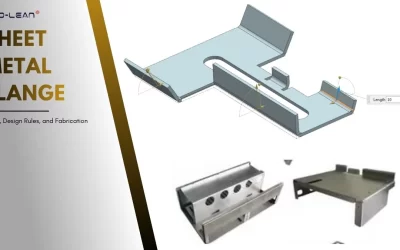
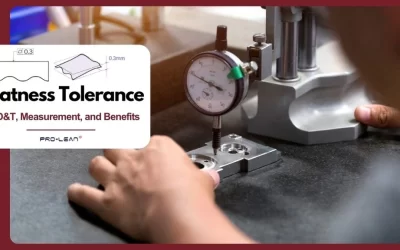
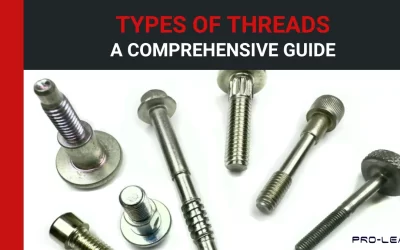
0 Comments